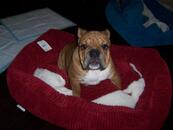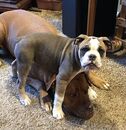chitownbully
Member
- Nov 23, 2015
- 69
- 1
- Country
- USA
- Bulldog(s) Names
- KINGSTON / PRINCE
Hello All,
My 5 month old bully was diagnosed with D-mange yesterday. As of today i've included coconut oil into his daily feedings and I would like to apply coconut oil on his skin, especially where fur is thinning. My question is after application do i need to rinse him off? From what i've read it'll probably get worse before it gets better. I'm trying to do what i can to prevent this from happening. He is currently on a Ivomec.
Also is there anything else i can don or give him to stop the hair loss, as i know it takes forever to grow back
My 5 month old bully was diagnosed with D-mange yesterday. As of today i've included coconut oil into his daily feedings and I would like to apply coconut oil on his skin, especially where fur is thinning. My question is after application do i need to rinse him off? From what i've read it'll probably get worse before it gets better. I'm trying to do what i can to prevent this from happening. He is currently on a Ivomec.
Also is there anything else i can don or give him to stop the hair loss, as i know it takes forever to grow back








